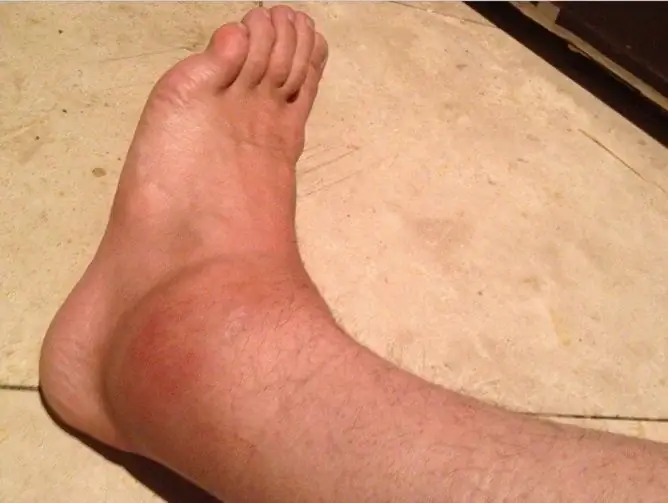- Author Rachel Wainwright [email protected].
- Public 2024-01-15 19:51.
- Last modified 2025-11-02 20:14.
Swelling of the nasal mucosa: causes, treatment
The content of the article:
- Causes of swelling of the nasal mucosa
-
What does the swelling of the nasal passages lead to?
- Impaired nasal breathing
- Violation of the cleansing function, smell recognition and change in the timbre of the voice
- Development of complications
-
Treatment of swelling of the nasal mucosa
- Treating an infection
- Allergy treatment
- Elimination of deformation
- Video
Swelling of the nasal mucosa is a pathological condition resulting from many diseases. It is a consequence of excessive blood vessels filling and their increased permeability. It is accompanied by a violation of the breathing process, in the absence of adequate treatment - oxygen starvation of tissues. It leads to a decrease in the protective functions of the nasal cavity, makes it difficult to perceive odors and the formation of sounds.

Swelling of the nasal mucosa interferes with normal breathing and creates other problems.
Causes of swelling of the nasal mucosa
There can be many etiological factors that provoke edema of the inner lining of the nasal cavity:
- infectious (viral, bacterial diseases);
- allergic (plant pollen, animal hair, house dust, mites, mold spores, food products, medicines);
- traumatic (mechanical damage, toxic chemicals, temperature effects);
- anatomical (curvature of the septum, deformation of the turbinates, neoplasms).
Nasal congestion is only a symptom of various diseases, and not an independent nosological unit. Swelling of the mucous membrane practically does not exist in isolation, but is accompanied by a runny nose, burning sensation, sneezing, lacrimation, sometimes fever and pains of various localization and intensity. The combination and severity of complaints depends on the pathology underlying their appearance.
|
Etiological factor |
Explanation |
| Infectious diseases | Acute respiratory infections of viral origin (adenovirus, parainfluenza, rhinovirus, etc.) are the most common cause of edema of the nasal passages. Bacteria rarely act as a trigger for congestion, much more often they cause complications. |
| Allergic diseases | Their number is growing rapidly as a result of the deteriorating environmental situation, the use of household chemicals, the presence of occupational hazards, and smoking. |
| Damage to the nasal passages | It occurs with mechanical injuries (abrasions, bruises, fractures). Prolonged hypothermia, thermal and chemical burns, particles of industrial waste contained in the inhaled air lead to a violation of the integrity of the epithelium and excessive blood flow. Irritants of this kind enter the body when working in hazardous industries. |
| Anatomical obstacles | Curvature of the septum, congenital narrowing of the passages, deformation of the shells, retraction of the back of the nose also interfere with breathing freely and provoke swelling of the mucous membrane. In addition to anatomical defects, polyps, foreign bodies, and neoplasms serve as an obstacle to the air stream. |
Whatever the cause of nasal congestion, it disrupts the functioning of the organ, and also worsens the general condition of the body. Why? Because the body does not receive the oxygen necessary for tissue nutrition.
What does the swelling of the nasal passages lead to?
The performance of the respiratory, protective, olfactory functions by the nose directly depends on the state of its inner shell.
Impaired nasal breathing
Severe swelling makes nasal breathing difficult, in which the chest expands more fully than when inhaling through the mouth, and oxygen is supplied to the tissues. The lack of the latter negatively affects the work of human organs and systems.
Violation of the cleansing function, smell recognition and change in the timbre of the voice
Only when the mucous membrane is in a normal state, the air passing through the nasal cavity is warmed, humidified, cleaned of dust and microorganisms, and odorous substances penetrate to sensitive receptors, triggering the odor recognition procedure. Edema disrupts not only these processes, but also prevents the correct formation of sounds. As a result, the timbre of the voice changes, and nasality appears.
Development of complications
Lack of timely correction and predisposing factors lead to the development of complications. Low immunity, systemic and endocrine diseases, varieties of pathogenic microflora that are resistant to antibiotics contribute to their appearance. The latter is especially important, since it is bacterial infections that most often cause negative consequences.
The spread of the inflammatory process from the nasal cavity to the mucous membrane of one or more paranasal sinuses leads to the development of sinusitis. The maxillary and frontal sinuses are more often affected. Inflammation of the first - sinusitis, the second - frontal sinusitis. A breakthrough of pus into the surrounding tissues with ineffective treatment of bacterial sinusitis provokes the involvement of the orbit and even the meninges in the pathological process.
Treatment of swelling of the nasal mucosa
The choice of drugs to eliminate nasal congestion directly depends on its nature. For an effective and lasting result, symptomatic correction is not enough; it is necessary to influence the cause of the disease. Both the lack of adequate treatment and the long-term uncontrolled use of medications are unacceptable.
Treating an infection
In acute viral infections, you can limit yourself to the use of vasoconstrictor drops. By acting on the muscle layer of the vascular wall, they reduce their lumen and facilitate breathing. It is recommended to use such funds for no more than 5-7 days. During this time, the body usually copes with viruses. Prolongation of admission leads to a malnutrition of the cells of the mucous membrane and the occurrence of drug-induced rhinitis. Bacterial infections require antibiotics.

Vasoconstrictor drops help relieve swelling of the nasal mucosa, but do not eliminate its cause
With nasal edema of microbial origin, rinsing of the cavity with saline solutions is indicated. The procedures contribute to the mechanical cleansing of the passages from mucous and purulent discharge, relieve congestion. Salt solutions can be prepared at home or purchased at the pharmacy. Other folk methods are also appropriate, you can do irrigation with decoctions of herbs (chamomile, sage, horsetail), inhalations with essential oils (eucalyptus, cedar, fir).
Allergy treatment
To get rid of allergic puffiness, contact with the allergen is excluded, in parallel, antihistamines of local and systemic action are used. Sprays and drops quickly relieve itching and sneezing. Tablet preparations of ӀӀ and ӀӀӀ generations are devoid of a hypnotic effect, do not disrupt the work of the gastrointestinal tract, therefore they are taken for a long time. With a persistent course of allergies, they resort to sprays containing corticosteroid hormones. Intranasal administration increases their safety profile.
Elimination of deformation
Conservative treatment of nasal septum congestion is not enough. Only prompt elimination of anatomical deformities can achieve a lasting result. Surgical intervention is also used for injuries that violate the structure of the nose. During the recovery period, antimicrobial agents are shown, at later stages - oil solutions that prevent the formation of crusts.
Video
We offer for viewing a video on the topic of the article.

Anna Kozlova Medical journalist About the author
Education: Rostov State Medical University, specialty "General Medicine".
Found a mistake in the text? Select it and press Ctrl + Enter.






